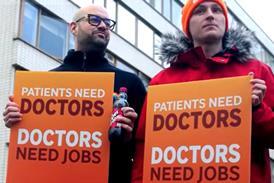- Record 2,347 trolley waits in December alone – eight times more than previous December
- The “shocking” figures meet widespread warnings NHS is trapped in spiral of decline
- HSJ analysis shows depth of quarterly decline on four-hour target and trolley waits
The NHS saw a record decline in emergency care performance during the last three months, official data published today reveals.
There were a record 2,347 breaches of the 12-hour from decision to admit target last month – around eight times the 284 recorded in December 2018, according to the official monthly data.
Performance against the four-hour A&E target in December overall slumped to a record low of 79.8 per cent – around seven percentage points lower than the 86.5 per cent recorded in December 2018.
Performance for major “type one” emergency departments in December hit a record low of 68.6 per cent – around 10 percentage points lower than the 79.1 per cent reported in 2018.
Senior medics warned the failure to meet the access targets for years “now seems to have been ‘normalised’ and appears to be routinely ignored”.
December’s performance follows months of continuous decline.
Analysis by HSJ of official accident and emergency performance quarterly data also published today, shows the drop in performance in the third quarter of 2019-20 represents an unprecedented step-change in declining performance.
The analysis reveals:
- There were a record 4,185 trolley waits for quarter three 2019-20, over half of which were reported last month. This is more than three times the 1,262 reported for the same period in 2018-19, which was the previous highest number recoreded during a third quarter.
- Overall four-hour performance was 6.1 percentage points lower in quarter three 2019-20 (81.6 per cent) than in the same quarter a year earlier. This is nearly double the size of the next biggest year-on-year fall for the third quarter which saw a 3.6 per cent drop between the third quarters of 2015-16 and 2016-17 (see graph below).
- Type one four-hour performance was nearly 10 percentage points lower in the third quarter 2019-20 than the previous year, down to 71.5 per cent from 81.2 per cent – another unprecedentedly large slide.
Nuffield Trust chief economist Professor John Appleby said: “These would be dire performance figures for any December but what’s worrying is that we are still awaiting the truly cold winter weather that we know will plunge the NHS into further problems.
“Once a rare and almost unthinkable event, in December over two thousand people waited more than 12 hours on a trolley to be admitted to a bed on a hospital ward. Last month also saw over 98,000 people waiting more than four hours on a trolley. We warned this could top 100,000 as winter goes on and at this rate it could get even worse. Missed targets are now the norm with more than one in five people attending A&E waiting longer than four hours to be admitted to hospital, transferred or discharged home.
Royal College of Emergency Medicine president Katherine Henderson said: “The NHS is struggling to escape its spiral of decline. With a record low in terms of four-hour performance and highest ever number of 12-hour waits, this will have been a miserable Christmas period for many patients and staff alike.”
Nick Scriven, immediate past president of the Society for Acute Medicine, said: “This delayed release of a large amount of data shows just what a struggle the NHS faces to meet long-standing targets under ever-increasing demand across the board but hides the fact that staff are on their knees trying to keep patients safe.
“Sadly the failure to meet the access targets for years now seems to have been ‘normalised’ and appears to be routinely ignored or, perhaps worse, minor parts of the data spun for any positive effect that can be gained.”
NHS medical director Stephen Powis said: “A&Es across the country are currently very busy – in 2019 we treated over a million more patients in our A&Es than the previous year. The continued increase in people’s need for care underlines the need for more beds and staff across hospital and community services, which is why the government’s commitment to increase the number of nurses by 50,000 and invest in new and expanded facilities will be crucial over the coming years.”



























22 Readers' comments